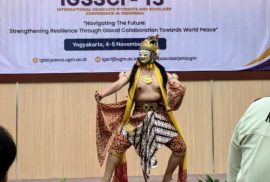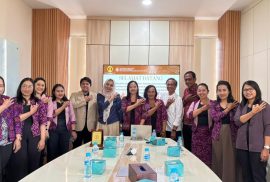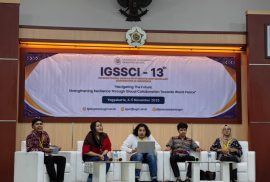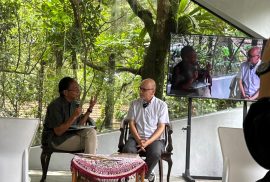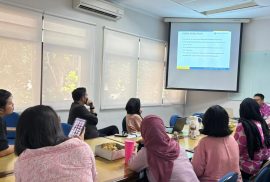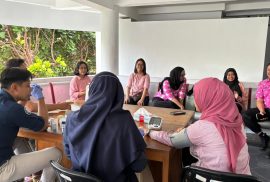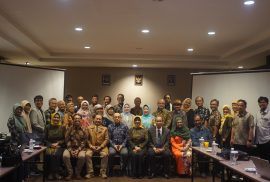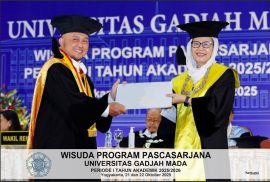I Made Christian Wiranata Rediana, an alumnus of the Study Program of Performing and Visual Arts Studies (PSPSR), delivered a captivating performance at the closing of the International Graduate Scholars’ Conference in Indonesia (IGSSCI) on November 5, 2025,by presenting the Topeng Gunung Sari dance. Redian’s performance became the impressive highlight of the event, combining the beauty of traditional Javanese performing arts with the spirit of cultural preservation in line with the Sustainable Development Goals.
News
Yogyakarta, November 12, 2025 — In an effort to strengthen institutional relations and enhance academic coordination between higher education institutions, the Faculty of Dharma Acarya, Universitas Hindu Negeri (UHN) I Gusti Bagus Sugriwa Denpasar, conducted an educational visit to the Doctoral Program in Performing and Visual Arts Studies, Graduate School of Universitas Gadjah Mada (UGM) on Wednesday, November 12, 2025.
Commencing at 8:00 a.m. local time, the visit aimed to monitor the academic progress of a faculty member, I Gede Tilem Pastika, who is currently pursuing his doctoral studies at the mentioned program.
Two students from the Master’s Program in Performing and Visual Arts Studies (PSPSR) at Universitas Gadjah Mada have achieved a remarkable accomplishment by presenting their research findings at the International Graduate Students and Scholars’ Conference in Indonesia (IGSSCI) 2025. This prestigious event, organized by the Graduate School of Universitas Gadjah Mada on November 4-5, 2025, carried the overarching theme Navigating The Future: Strengthening Resilience Through Glocal Collaboration Towards World Peace, emphasizing the importance of global-local collaboration in building resilience to face future challenges.
Yogyakarta, November 7th, 2025 – In commemoration of National Wayang Day which celebrated annually on November 7th, CEMPALA (Centre for Multidisciplinary Puppetry Arts Learning and Appreciation) is proud to present “Wayang World 2025,” a comprehensive celebration showcasing the global, diverse, and modern dimensions of this Indonesian art—recognized as a world intangible cultural heritage by UNESCO. The event organized in association with esteemed institutions, including Yale University Art Gallery, Ullen Sentalu Museum, Sonobudoyo Museum, and Universitas Gadjah Mada (PSPSR and FIB), held on Friday, November 7, 2025, utilizing a hybrid format (online and on-site). To reach a global audience, the event is also available for live streaming via Cempala’s website (www.cempala.com), Ullen Sentalu’s YouTube Channel, and Zoom Meeting, adapting to different time zones.
On October 29, 2025, the fourth Forum Rabu Wagen took place at the Graduate School, Universitas Gadjah Mada. Featuring two Doctoral program students as speakers and attended by about 10 students of the performing arts and visual arts studies program. The first speaker, Ashar Murdihastomo, with the title of his presentation, Perubahan Visual Arca Batu Siwa Mahadewa Abad ke 14-15 Masehi di Jawa: Kajian atas Ketidakhadiran Ikon Khusus Tokoh Dewa, provided in-depth knowledge sharing on the topic. The second speaker was Anon Suneko with the topic title, Gending Pakualaman Yogyakarta Periode Paku Alam IX – Awal Dekade Paku Alam X: Garap dan Identitas. This is an interesting topic that has attracted students who want to delve further into related areas. Through this forum session, students can not only understand new topics in art studies but also be inspired to improve the quality of their studies, enabling them to make new contributions in their fields. This once-a-month event will be held again this November with two more speakers who will share their latest research results. This activity supports SDG 4 – Quality Education, by fostering academic dialogue and knowledge sharing among doctoral students, encouraging research development, and enhancing the quality of higher education in the arts. (Hajar Aznam)
On October 29 2025, before the start of the Forum Rabu Wagen event, the Performing Arts and Fine Arts Study Program held a health screening session for all doctoral program students at PSPSR. Members of the UGM Postgraduate School (Postbindu) carried out this health screening session. This health screening session includes assessments of body mass index, blood pressure, blood sugar, cholesterol, and uric acid levels. The Health screening session has provided students with awareness of their current health status and the importance of maintaining their health. This event seems suitable for implementation each semester to ensure PSPSR students remain in optimal condition. Meanwhile, students enhance physical and mental stability while adhering to the recitation standards. This activity supports SDG 3 – Good Health and Well-Being, by promoting health awareness and preventive care through regular health screenings for PSPSR UGM students. (Hajar Aznam)
Bandung, October 22, 2025 — The Leader’s Summit Pascasarjana, a strategic forum that brings together Heads and Coordinators of Graduate Programs in Art, Design, and Art Education from various universities across Indonesia, was once again successfully held. This forum serves as a platform for dialogue and collaboration to strengthen the academic direction of art and design studies amidst the rapidly changing times.
Initiated in 2024, this year’s summit carried the theme “Strengthening Collaboration Among Graduate Programs in Art, Design, and Art Education in Indonesia,” and took place at Universitas Pendidikan Indonesia (UPI), Bandung. The main focus of the forum is to enhance creativity, research capacity, and managerial strength of study programs to effectively respond to the challenges of research-based and innovative higher education.
The Graduate School of Universitas Gadjah Mada held a solemn Graduation Ceremony for Period 1 of Academic Year 2025/2026. This festive event was enlivened by students from the Master’s Program in Performing and Visual Arts Studies (PSPSR), Janur Pusparukmi and Rusnandi, who performed the Ronggeng Nyentrik Dance.
The involvement of both PSPSR students in this prestigious event demonstrates the study program’s commitment to integrating theory and practice in performing arts. The Ronggeng Nyentrik Dance presented is a form of traditional art preservation packaged with contemporary interpretation, reflecting the continuously evolving dynamics of Indonesian culture.
Yogyakarta, 22 October 2025 — Universitas Gadjah Mada once again held its graduation ceremony for postgraduate students on Wednesday, 22 October 2025. This event marked a historic milestone for graduates who have completed their academic journeys at the master’s and doctoral levels. The solemn ceremony took place at the Grha Sabha Pramana (GSP) building from morning until noon, followed by individual faculty and school ceremonies.
From the Doctoral Program in Performing Arts and Visual Arts Studies (PSPSR)at the UGM Graduate School, two doctoral students were officially conferred their degrees: Dr. Panakajaya Hidayatullahand Dr. R. Bima S. Raharja. Both graduates achieved remarkable academic accomplishments and made significant contributions to research in the fields of art and culture. The Graduate School’s ceremony continued at the UGM Postgraduate Building, featuring remarks from school leaders and academic supervisors who expressed their appreciation for the graduates’ dedication and scholarly excellence.
Yogyakarta, 22 October 2025 — Universitas Gadjah Mada held its Postgraduate Graduation Ceremony on Wednesday, 22 October 2025, at the Grha Sabha Pramana (GSP) building. This solemn academic event marked a significant milestone for graduates who have completed their scholarly journey at the master’s and doctoral levels. The ceremony proceeded smoothly and concluded on schedule, followed by individual recognition events held at each respective faculty and school.
From the Graduate Program in Performing Arts and Visual Arts Studies (PSPSR), fourteen master’s students were officially conferred their degrees. Among them, eleven graduates achieved the cum laude distinction, while three graduates received the very satisfactory predicate. These achievements reflect the dedication, perseverance, and academic excellence of PSPSR students throughout their studies and research in the fields of art and culture.

